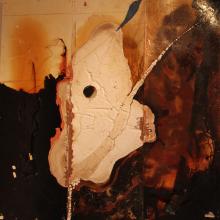
Simon Pontin is a freelance chef, musician and artist currently working in Edinburgh (www.simonpontin.com).
He 'loosely adheres' to the principles of Transpersonal Art, seeking through meditation and creativity to transcend the physical qualities of his materials and discover or express a spiritual reality.
This 'journey' is experienced through mixed media: large, abstract, combinations of wood, glue, plastic and paint, from which – despite the artist's disdain for the physical – many observers will derive great sensory pleasure. His work plays with colour and texture, highlights the beautiful and transformative processes of decay as rot and mould re-create organic substances. For all its fungal, decomposing appearance, it even smells good, thanks to the use of spices in some of the pigments.
These highly accomplished works explain, for the artist alone, personal and internal processes of meaning and imagery. Such processes are not elucidated by titles like 'Eloquently Evolutionary Exercise' (top right), 'Posthumus Patriarchal Portal' and 'Requisite Retrospective Reality'. Fortunately, other virtues in Pontin's work more than compensate for such irritating alliterative obscurity.
[img_assist|nid=1601|title=|desc=|link=node|align=right|width=640|height=576]Very different is the work of Frank McGonigal, who has been fasincated by the architecture of David Bryce (1803–76) since a 1960s childhood in Crosslee near Glasgow introduced him to the then ruinous Craigends House.
The grandson of Italian Impressionist Gianni Brumatti, McGonigal went on to Edinburgh College of Art, emerging in 1996 with a BA. It was in the mid '90s that this reviewer first encountered him in Broughton, a man fixated on the Gothic pinnacles of Fettes School (another Bryce design): McGonigal returned to paint them again and again in all kinds of weather and from every conceivable angle.
His interest in the monumental qualities and excesses of cityscapes, and the position of people within them, is amply reflected in this exhibition.
There are four classically inspired scenes showing naked or semi-clad figures dwarfed by enormous, ruined baths and temples. At first these are reminiscent of Claude Lorrain's idealised landscapes, but Edinburgh influences are also clear: the variety of street levels approached through arches and steps remind one of a Calton Road arch under a processional way, or Old Town vennels, or the interiors of massive banks. (Bryce also designed the Bank of Scotland on the Mound.)
McGonigal's vision appears at first rather formal, austere, masculine, Roman. His figures may have a semi-naked innocence about them, but they can also seem oppressed by the imposing height, weight and history of the masonry around them. The wreckage of this past civilisation is, I find, both poignant and threatening, like some Fascist ceremonial-space in the wake of an apocalypse.
That tension transfers to the artist's contemporary Edinburgh scenes. Typically his foregrounds are rendered in somewhat murky blues and greys. But these solemn faces he invigorates with astonishing slantways sunlight: the Forth seen under rain storms from Salisbury Crags; South St David Street and the summit of St Giles suddenly detailed in afternoon shafts.
North Bridge (above) he depicts with clusters of people walking along the pavements. There is an odd stillness to this image, little sense of a modern city's random bustle. LRT buses punctuate the road, but seem like statues. This is Edinburgh frozen in time, perhaps Edinburgh as another imagined classical city congealing in the last days before its collapse.
McGonigal is immensely skilled at conveying the mass of built structures, but the sensibility which drives him to celebrate and undermine them is equally well expressed and thought-provoking. AM
Both exhibitions continue at Axolotl Gallery (35 Dundas Street) until 4 April, Wednesdays–Saturdays, 11:00am–4:00pm.